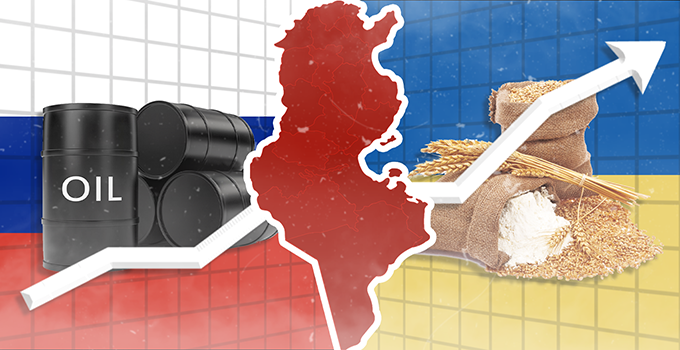
Once considered one of Tunisia’s food baskets, producing abundant olive, orange, watermelon and tomato crops, Sidi Mahmoud is slowly turning into desert. Water scarcity has driven many farmers away from the area. Most have lost all of their income. Many have sold their farming equipment to feed their families, others have left for neighboring cities or even headed overseas in search of new livelihoods.
Our crops don’t yield anything anymore because of the ongoing drought in the region, so I had to give up farming. I drive a cab now. I moved with my family to the center of Kairouan
says Chaker Sibri, a former farmer from Sidi Mahmoud.
Like neighboring North African countries, Tunisia has a long history of coping with water scarcity. “The Roman aqueduct and canal network built in the second century are works that testify how far back the water shortage problem stretches in Tunisia”, notes Dr. Hassane Mouri, a sociologist specializing in the environment and development. But the impacts of climate change and the country’s agricultural policies dating back to its independence have exacerbated the water issue.
Since 1956, Tunisia has primarily used surface water capture techniques, even though the country’s rainfall is characterized by high inter-annual variation and poor spatial distribution. In 2020, average rainfall was 36km3 (with rainfall levels varying between 1,500 mm in the northern regions to less than 100mm in the south) according to the Ministry of Agriculture; only 2 to 3km3 were captured. Water resources and development remain largely dependent on rain. Tunisia also suffers from a regional imbalance in available water resources. While the country’s northern regions enjoy 80% of surface water resources, the South claims a mere 5% of surface water.
Renewable water resource availability today amounts to 420 m3 per year per inhabitant, which is below the absolute water scarcity threshold of 1000m3 (Food and Agriculture Organization, AQUASTAT data 2018). If no major changes occur in the coming years, water resources are expected to continue to decrease, and may fall to 150m3 by 2050.
Agriculture and irrigation: the largest water consumers
Like many other Middle Eastern and African countries, Tunisia has for decades pushed farmers to specialize in industrial crops for exportation. Most of these crops—strawberries, tomatoes, melons—are very high water consumers. This specialized agriculture has replaced traditional production which was dedicated to feeding the local population.
Surface water resources in Tunisia are burdened by problems of both quantity and quality. Because of the multi-year drought and general rainfall variability over the last decade, as well as global warming and poor maintenance of an aging infrastructure, the quantity and quality of usable water flowing through Tunisia’s large dams is only half of what it should be. According to the National Agriculture Observatory (ONAGRI, 2015), the salinity of about half of the country’s water (53%) is greater than 1.5 grams, while 35% of water has a salinity above 2 grams. Since the Tunisian revolution, thousands of wells have been dug illegally, leading to an overexploitation of the water table and worsened quality of available water.

“We have to go deeper and deeper to find water,” says Chaker Sibri, the 54-year-old farmer from Sidi Mahmoud. “We need to dig down to 300 meters to find water. Even if three or four of us join together, we can’t afford the cost of digging that deep”. In 2016, drought-related agricultural losses in Tunisia amounted to an estimated 2 billion dinars (905 million dollars), according to the Tunisian Agriculture and Fishing Union (UTAP).
Drought and heat destroy crops, increase poverty and worsen nutrition
Adopting changes in Tunisia’s agricultural sector is a matter of extreme political sensitivity. The country’s high dependence on international markets means that basic agricultural products are vulnerable to extreme price fluctuations. A salient example of this is how the war in Ukraine has impacted wheat imports and left Tunisia suffering from inflation and a shortage of basic food items.
According to the 2015-2020 report from the National Institute of Statistics (INS), fruit and vegetable prices increased during this period by 135%, thereby becoming largely inaccessible to much of the population. Such soaring price increases contribute to disparities in terms of food sovereignty and to the deterioration of health nationwide. The number of malnourished and underweight Tunisians rose beginning in 2014. At the same time, obesity and food waste are also on the rise. Representing on average nearly 30% of household expenditures, food is the largest expense for Tunisian families, more costly than housing, electricity or water. This means that food prices greatly impact general living conditions, and indeed price increases often lead to protests, which in turn helps to explain the acute political sensitivity around changes in the agricultural sector.
Tunisian politicians have traditionally responded to this sensitivity by subsidizing consumer prices for certain food items, thus keeping the cost of certain goods relatively low. But in the past few years, the government’s balance deficit has made it increasingly difficult to meet the needs of Tunisians. The COVID-19 pandemic and resulting health crisis only aggravated the situation facing Tunisia’s fragile economy, which has faced structural obstacles relating to political instability since the 2011 revolution. The country’s GDP in 2020 fell by 8.6% from the previous year, the budget deficit grew to 10.2% of the GDP, while public debt reached 89.74% of the GDP in 2020. The highest poverty rates are concentrated in rural areas, especially in the northwest and southwest of the country (where they often exceed 33%). Decreased income for farmers combined with poor crop production is also contributing to malnutrition, since a large percentage of the population makes a living from farming (10% in 2021).
2.1% of Tunisian children under five years of age are affected by wasting syndrome, compared with a 6% average across Africa. Latifa Beltaif, a nutritionist based in Tunis, points to a lack of essential nutrients, what she refers to as “noble proteins”, in the diet of most Tunisians.

Chaker Sibri, the small-scale farmer in Sidi Mahmoud, recounts, “A couple of days ago, my son asked me about the last time I’d brought fish home. The sad thing about it is that I’ve been to the market, but keep walking around with no chance of buying any fish as prices are absolutely more than what I can afford”.
The World Food Programme 2022 report confirms that Tunisia faces overlapping nutrition problems, including deficiencies in vitamins and minerals. An estimated 28% of children under five as well as nursing mothers are reported to be iron-deficient.
Dr Beltaif notes that, “Most of these problems can be solved through guidance around consumption patterns and a push towards quality, diversified nutrition.”
Climate-smart intervention
Hundreds of Tunisians have lost their livelihoods due to the effects of climate change and environmental issues. But human activity has also taken an economic toll. Meeting increasing demands for water while accounting for the space and time imbalance of water quantity and quality makes water scarcity one of the most urgent problems facing the country. The solution, however, is not limited to dealing with water scarcity; indeed, there are also the issues of governance and speculation in food prices. Habib Ayeb, a social geographer and water expert, observes that, “We consider the issues of nutrition, water scarcity, and agriculture in general to be strategic questions, whereas these should not be contemplated as sources of investment or financial speculation”.
It is vital that Tunisia reevaluate its water resources in general, fight wasted water resources, and combat mismanagement in pricing for water destined for drinking, irrigation systems, and urban use. As water scarcity intensifies, the country’s agricultural map must change. Most of the experts consulted in the context of this report (Hassan Mouri, Habib Ayeb, Raoudha Gafraj) agree that it is necessary to limit the crops planted in accordance with their water consumption. “By exporting melons, tomatoes and other vegetables and fruits that are high water consumers,” Mouri tells us, “Tunisia is exporting water even while it can’t satisfy its own water needs”.





iThere are no comments
Add yours